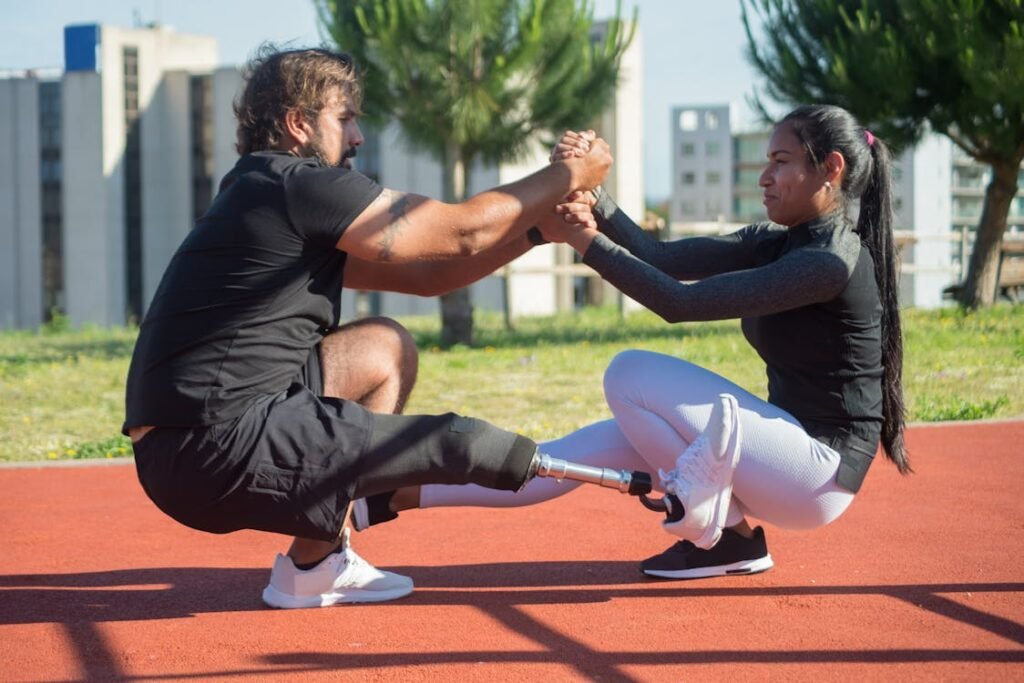Pain after an amputation isn’t always in the limb that was lost — it often shows up in the places that remain. For many amputees, the journey doesn’t end with getting a prosthesis. It continues through small aches in the back, tightness in the hip, or sharp pain in the knee that wasn’t even operated on. These issues can be confusing, frustrating, and exhausting.
The reason is simple: after limb loss, the way a person walks completely changes. And if those changes aren’t addressed early and properly, they can slowly cause wear and tear in other parts of the body. What starts as a slight limp or small posture shift can lead to long-term discomfort — or even serious injury.
That’s where gait training comes in.
Gait training isn’t just about learning to walk again. It’s about protecting the rest of the body — keeping it aligned, balanced, and pain-free. When done right, gait training helps amputees move more naturally, avoid overuse injuries, and build a solid foundation for lifelong mobility.
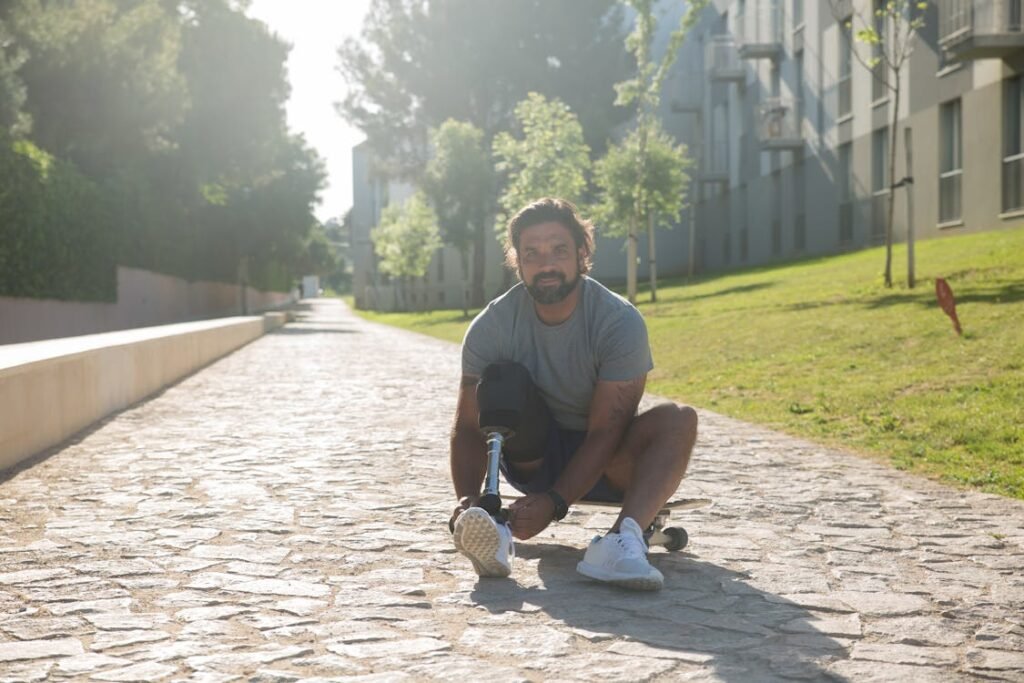
Why Amputees Experience Pain in the Back, Hip, and Knee
Pain Doesn’t Always Start Where You Think
After an amputation, the body doesn’t just adjust to the missing limb. It begins to shift everything — the way you stand, the way you walk, and even the way you sit. These changes might not be obvious at first, but they create pressure in areas that were never meant to carry extra load. Over time, this pressure leads to pain. And that pain often shows up in places like the lower back, the hips, or even the knee on the opposite leg.
When one leg is removed and replaced with a prosthesis, the body automatically tries to “protect” itself. It leans away from the prosthetic side. It puts more weight on the sound limb. It adjusts the tilt of the pelvis. These small compensations might help with balance in the short term, but they come with a cost. Over time, these postural changes can strain muscles, overwork joints, and create misalignment in the spine.
This kind of compensation is natural. The body is trying to stay upright and mobile. But without the right guidance, it often does so in a way that leads to discomfort and uneven movement. That’s why pain in the back or hips doesn’t usually mean something is “wrong” with those areas — it means those areas are being overused or misused due to poor gait mechanics.
How the Sound Limb Takes the Brunt of It
When someone loses a leg and begins walking with a prosthesis, it’s very common to rely too much on the sound limb. That’s the leg that still feels “normal” and strong. So naturally, the body places more trust in it. The person might unconsciously shorten their steps with the prosthetic leg or hesitate to put full weight on it. As a result, the sound leg ends up working overtime.
Over time, this imbalance leads to pain — especially in the knee and hip of the sound side. That leg is absorbing more impact with every step. It’s pushing harder, bending more, and supporting the full weight of the body for longer. This kind of overuse can wear down cartilage, irritate soft tissues, and place stress on the joints. What starts as mild soreness can turn into chronic pain or even long-term injury.
Many amputees don’t realize how much extra stress their sound limb is taking. They think the pain is just part of adjusting. But with proper gait training, that pressure can be reduced significantly. By learning how to trust the prosthetic side and distribute weight evenly, the workload can be shared between both legs — relieving the burden on the sound knee and hip.
The Role of Pelvic Tilt and Spinal Strain
Another common issue among amputees is pelvic imbalance. After limb loss, the height and movement of the pelvis can change. If the prosthesis isn’t aligned correctly — or if the user has learned to compensate through hip hiking or leaning — the pelvis may tilt or rotate during walking. That movement might seem small, but it affects the entire spine.
The spine depends on a level pelvis to stay aligned. When the pelvis tilts, the spine has to curve to keep the head upright. That curve places pressure on the lower back, especially on the muscles and discs that support the lumbar region. Over time, that pressure can cause stiffness, soreness, and even nerve pain.
A tilted pelvis also changes how the core muscles work. Instead of supporting the spine naturally, they start to tighten unevenly. One side might become overactive, while the other weakens. This imbalance further contributes to back discomfort and reduces stability while walking.
Gait training addresses this by teaching the user how to keep the pelvis steady during movement. With the help of mirrors, guidance, and physical exercises, users learn how to walk with a level, balanced posture. This doesn’t just improve how they walk — it protects their back from unnecessary strain and reduces their risk of future spinal problems.
Why Pain Doesn’t Always Show Up Right Away
One of the most deceptive things about post-amputation pain is that it often shows up months after walking has started. In the beginning, the user may feel focused on wound healing, socket fit, or simply getting used to the prosthesis. They might not even notice how they’re walking. But as weeks turn into months, the small compensations begin to add up. That’s when the pain begins.
This delayed pain can be confusing. The prosthesis might feel fine. The user may think they’re walking normally. But the body knows otherwise. It’s been managing imbalances quietly until it can’t anymore. That’s when back spasms, hip tightness, or knee aches appear seemingly out of nowhere.
Early gait training helps prevent this pattern. By starting proper movement education early in the rehab process, the body is guided into good habits from the beginning. This reduces the need for compensation, helps muscles stay balanced, and lowers the chance of long-term pain. It’s not just about moving — it’s about moving the right way, from day one.
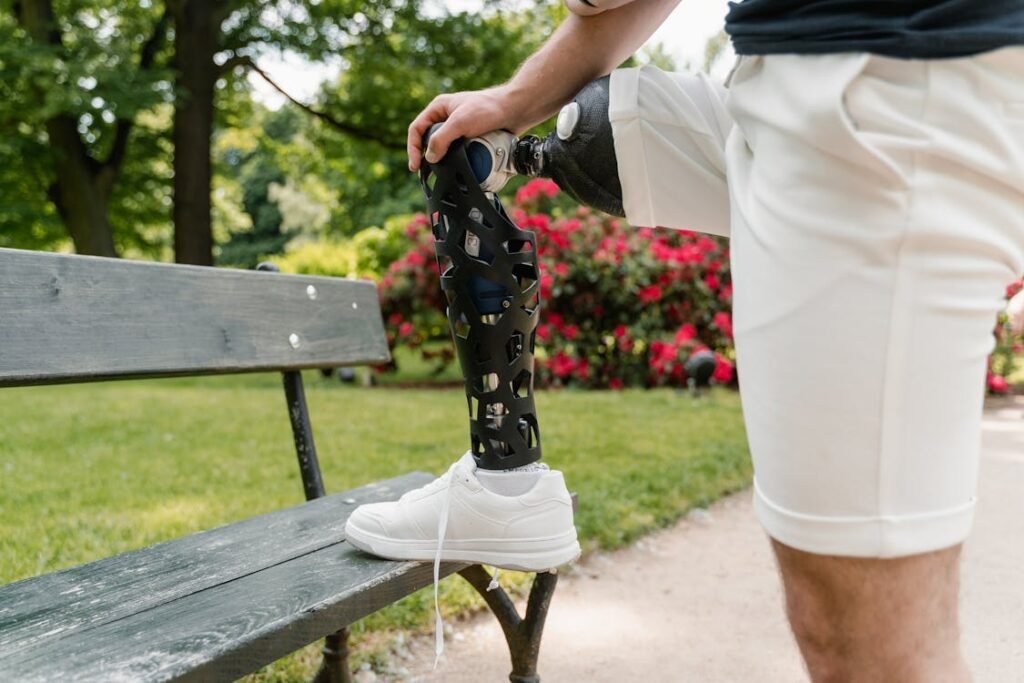
How Gait Training Protects the Body From Head to Toe
The Foundation of Healthy Movement Starts With Proper Steps
The way we walk — our gait — is something most people take for granted. But after limb loss, walking becomes something that must be relearned from the ground up. And it’s not just about moving forward. Every part of the body, from the feet to the head, plays a role in keeping that motion smooth and safe.
When gait training is skipped or done incorrectly, the body adapts — but not always in a good way. It starts to find shortcuts. These shortcuts may help with balance or make movement feel easier at first, but over time, they place uneven stress on the joints and muscles. Think of it like driving a car with one flat tire. You can still move, but you’re putting pressure in all the wrong places. Eventually, something gives out.
Proper gait training is like rebalancing that car. It aligns the joints, corrects posture, and teaches the body how to share the load evenly. For amputees, this is especially important. One leg has changed completely. Without training, the rest of the body will try to compensate — and that’s how pain begins.
With professional gait training, the user learns how to avoid these compensations. They are taught how to position the pelvis, how to activate the core, how to shift weight naturally between both legs, and how to keep their upper body aligned with each step. These small adjustments, when repeated over time, create a walking pattern that feels more natural and puts less strain on the body.
The Back Responds to Every Step You Take
The spine is the central support column of the body. When walking, every step sends shock and force upward through the legs, hips, and into the lower back. If one leg is moving differently — as is often the case with prosthetic use — the spine must absorb those imbalances. Over time, the muscles around the spine become tense. The discs between the vertebrae are compressed unevenly. And pain begins to creep in.
This kind of back pain doesn’t usually appear as a sharp injury. It’s slow and dull. It feels like stiffness, soreness in the mornings, or discomfort after walking short distances. If not addressed, it can worsen — making it hard to stand for long periods or move comfortably through daily activities.
Gait training works to prevent this by improving spinal alignment through better body mechanics. When a prosthetic user learns to walk with even posture, the spine can stay upright and neutral. The muscles on both sides of the back work together instead of fighting against each other. This balance keeps the back healthier and more resilient, especially during long walks or when carrying weight.
Therapists also teach posture awareness during gait training. This helps users understand how to “reset” their spine during the day — whether standing, sitting, or moving. These skills go a long way in reducing lower back pain and keeping the spine supported throughout all daily activities.
The Hips Are the Body’s Powerhouse — and They Need Protection
The hips are where a lot of the walking power comes from. These joints help swing the legs forward and absorb impact with every step. For amputees, the hip muscles on the prosthetic side often work harder because they have to do what both the knee and ankle once did. And on the sound side, those same hip muscles are overused simply because that leg is doing more of the work.
Without proper gait training, the hips get overloaded. One hip may become tighter than the other. The pelvis may rotate too much during walking. The user might start leaning to one side or lifting their hip to help the prosthesis clear the ground. These habits not only cause hip pain but also throw off the entire walking rhythm.
Through focused gait training, users learn how to move the hips evenly and efficiently. Exercises are used to strengthen the muscles around the joint — especially the glutes, which stabilize the pelvis and protect the lower back. When both sides of the pelvis move in sync, walking becomes smoother and more comfortable. This also reduces the chances of developing bursitis, joint inflammation, or muscle strain in the hip area.
Even better, trained hips improve balance and reduce the fear of falling. Strong hips give the body better control during quick changes in direction or unexpected shifts in terrain. This sense of control adds confidence — and with confidence, the user becomes more mobile and independent.
How Proper Gait Offloads the Knee Joint
The knee — especially the one on the sound limb — is one of the most vulnerable joints after an amputation. Since the prosthetic side often takes less weight in the beginning, the healthy leg ends up doing more. This means the knee absorbs more force with every step. Over time, that added stress wears down the cartilage, strains the ligaments, and can even lead to osteoarthritis.
This is one of the reasons many long-term prosthetic users end up with knee pain or injuries on the side that wasn’t amputated. Their walking pattern might feel “good enough,” but it’s quietly putting extra work on one knee day after day.
Gait training helps correct this imbalance early. Users are taught how to walk with more symmetry — where both sides of the body carry their fair share of the load. They learn how to properly push off from the prosthetic side, use the knee on the sound side more efficiently, and keep the weight moving forward evenly.
Therapists also look closely at stride length, foot placement, and walking speed — all of which affect how much pressure goes into the knee joint. By making small corrections to how the user walks, they reduce the long-term wear on the knee and keep the joint healthier for years to come.
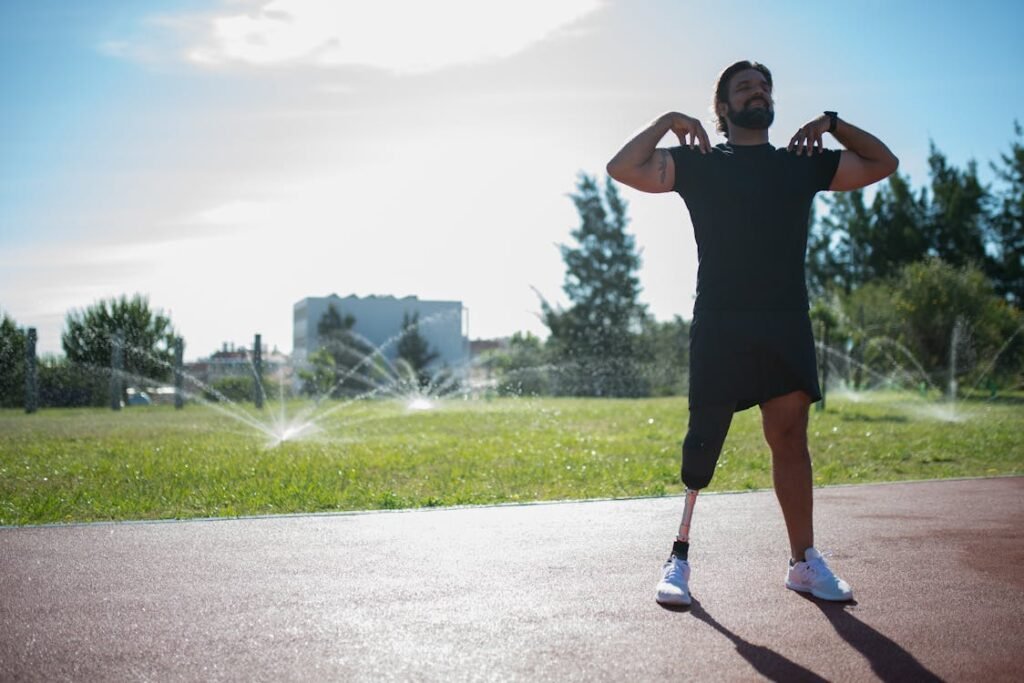
When Gait Training Begins Early, Pain Stays Away
The First Steps Matter the Most
The earlier gait training begins, the better the body adapts — not just to the prosthesis, but to the new way of moving. Right after an amputation, the muscles start to change. Some become weaker. Others tighten up from disuse or guarding. If these changes aren’t addressed right away, they can lead to stiff movement patterns and poor posture.
Many people assume that pain comes much later, as a result of aging or overuse. But often, it’s simply the result of starting gait training too late or skipping it altogether. What seems like a mild limp in the beginning can become a deeply ingrained habit that causes years of joint pain down the line.
Early gait training focuses on the basics: alignment, weight distribution, and controlled movement. It helps the user feel how to shift their weight over the prosthetic foot, how to stand tall without leaning, and how to keep their steps even. This foundation prevents the development of the lopsided, uneven walking patterns that lead to back, hip, and knee strain.
Even if someone is not yet ready for their full prosthetic fitting, early training with walking aids or pre-gait exercises can begin in physical therapy. These simple routines strengthen the core, loosen tight muscles, and prepare the body to move safely. The sooner this process starts, the smoother the transition — and the less pain the body experiences in the long run.
Breaking the Cycle of Overcompensation
One of the biggest causes of postural pain in amputees is overcompensation. The body is smart. When one part can’t do its job, another part steps in to help. This can be helpful in emergencies, but it’s not meant to last long. If left unchecked, overcompensation becomes the new “normal” — and that’s when pain starts.
Take the example of an amputee who always leans toward the sound side while walking. This may help them feel more secure, but it places constant stress on the spine and hip. Over time, this posture wears down joints and muscles. Eventually, the body can’t keep up, and pain flares up.
Gait training interrupts this cycle. It teaches the user to stop leaning, to use the prosthetic side more, and to trust the body’s center again. With regular practice, the brain begins to recognize this new pattern as the default. The result is a more symmetrical, pain-free walk that protects the whole body.
Some of these changes are subtle. A slight shift in pelvis position. A small change in foot placement. But the impact of these changes adds up. When the body moves with balance and coordination, it doesn’t have to overwork. That’s the real power of gait training — it doesn’t just teach movement. It restores balance.
The Mental Side of Pain Prevention
Pain is not just physical. It has a strong emotional and mental side too. When someone feels off-balance or awkward while walking, they often begin to fear falling. That fear makes them more cautious. They may take smaller steps, avoid walking altogether, or tense up during movement. Ironically, this fear-based tension makes pain worse — especially in the back and hips.
Gait training addresses this mental side of recovery as well. It builds confidence by teaching people how to move safely. As they gain more control over their gait, their fear of falling goes down. They start to walk with more freedom and less stiffness. This mental shift reduces the unconscious tension that can cause muscle fatigue and joint strain.
In fact, many people notice that once they feel more confident in their walking pattern, their pain naturally decreases — not because anything drastic changed, but because they stopped bracing or guarding their body with every step.
Confidence also encourages more movement, and more movement keeps the body healthy. When amputees walk more often and stay active, their muscles stay strong and flexible. That reduces pressure on joints and prevents the buildup of stiffness or inflammation. The cycle becomes positive instead of protective — and pain becomes something they leave behind.
Rehab Teams That Focus on Gait Make the Difference
A good prosthesis is essential, but it’s only as effective as the training that comes with it. The most successful amputees we’ve seen at Robobionics have one thing in common: a skilled rehab team that prioritizes gait training from the start.
Physical therapists, prosthetists, and rehab doctors who understand the connection between movement and pain take the time to build a strong foundation. They don’t just hand over a device and hope for the best. They guide every step, help the user recognize bad habits, and use practical exercises to improve posture, strength, and control.
These teams also know that gait training isn’t a one-time thing. As the user’s strength improves or their prosthetic needs change, so does their walking pattern. Ongoing check-ins, tune-ups, and movement assessments keep the body aligned and the gait healthy. This prevents minor issues from turning into major sources of pain.
A strong rehab team doesn’t just restore mobility — it prevents pain before it starts. And that’s what keeps amputees walking longer, feeling better, and living fuller lives.
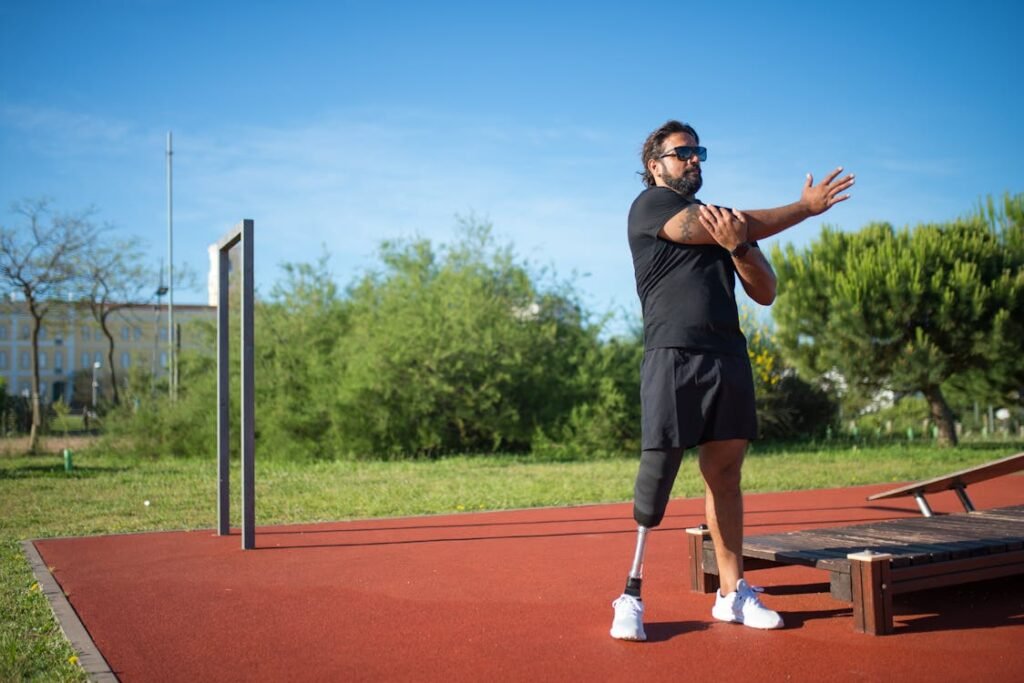
Real-Life Benefits of Pain-Free Gait: What Amputees Gain
Walking Becomes Natural Again — Not a Task
When someone is in pain, every step becomes a calculation. They think about where to place their foot, how to avoid discomfort, how to shift their weight, or how long they can walk before the aches start. This constant awareness takes a mental toll. Walking no longer feels automatic. It becomes something they dread or avoid altogether.
But with proper gait training, those patterns change. Once the body learns how to walk evenly and comfortably, those thoughts begin to disappear. Walking starts to feel natural again — something that doesn’t require constant correction or fear. Instead of bracing for pain, the person simply moves. And that feeling is liberating.
We’ve seen this time and again at Robobionics. Users who once limited their steps begin walking longer distances. They go out more. They rejoin activities they once gave up, like going for a morning walk, exploring a market, or visiting friends without worrying about how far they’ll have to walk. When pain fades, movement becomes part of life again — not something to plan around or avoid.
Freedom to Focus on Life, Not the Body
One of the quietest benefits of proper gait training is freedom from self-monitoring. Pain pulls your attention inward. You become hyperaware of every joint, every step, every minor ache. It’s exhausting. It also steals focus from the world around you — the people you’re with, the goals you have, and the moments that matter.
But once gait becomes stable and pain-free, that mental energy returns. The focus shifts outward. The amputee is no longer thinking about walking — they’re thinking about living. They can hold conversations while walking without worrying about posture. They can carry groceries, help a child walk across the street, or simply enjoy a stroll without checking their stride.
That shift — from thinking about the body to using the body freely — is one of the most powerful outcomes of early and consistent gait training. It’s not just physical relief. It’s mental space. And that space is what opens the door to a fuller, more confident life.
Better Sleep, Better Mood, and Less Stress
Pain doesn’t clock out at night. When the back or hip aches after a long day of uneven walking, it can interrupt sleep. Tightness in the lower back or a sore knee can keep someone awake or cause them to wake frequently. Over time, that poor sleep adds up — leading to fatigue, irritability, and even a dip in motivation for rehab.
But when gait becomes efficient and pain levels drop, sleep tends to improve too. The body doesn’t feel like it’s fighting itself all day. Muscles recover better, and the nervous system calms down. This deeper rest translates into better energy levels, more consistent moods, and a stronger desire to stay active during the day.
Pain also triggers stress. The body becomes tense. Breathing becomes shallow. Worry creeps in — about the pain getting worse, about falling, about not recovering fast enough. Gait training, by creating movement that feels controlled and smooth, can calm this stress. It gives the user something solid to rely on: their own body moving well.
It’s not uncommon to hear a user say, “I just feel lighter now.” That lightness isn’t just in the legs. It’s in the mind.
Long-Term Health: Preventing Bigger Problems Before They Start
One of the most overlooked truths in prosthetic care is this: the issues that show up early — minor back pain, slight knee aches, tightness in one hip — are often warning signs. They are the body’s way of saying something isn’t right. If ignored, these signals can grow into more serious problems over time, like disc herniation, hip arthritis, or chronic joint inflammation.
When someone walks with poor gait for years, their body pays the price. The joints wear unevenly. Muscles become imbalanced. And the chances of needing secondary treatments — injections, physical therapy, or even surgery — increase.
But when gait training is part of the recovery from the beginning, these problems can be avoided entirely. Teaching the body to move in a way that’s smooth, symmetrical, and natural protects the joints, keeps muscles working the way they should, and helps the body age more gracefully.
For younger amputees, this sets up decades of healthier movement. For older users, it means more years of independence and less reliance on pain medications or assistive devices. It’s not just about walking now — it’s about protecting your body for the long run.
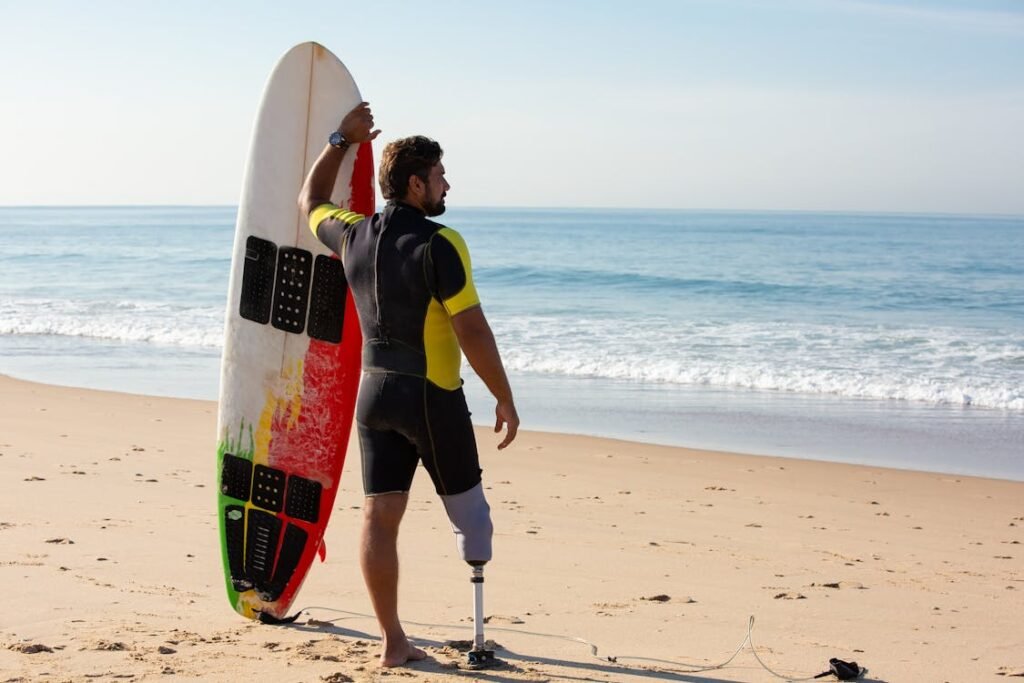
Adapting Gait for Different Terrains: A Key to Preventing Hidden Pain
Walking Isn’t the Same Everywhere
Most gait training happens indoors, on flat, smooth clinic floors. That’s where learning begins — it’s safe, predictable, and controlled. But real life doesn’t happen on polished tiles. It happens outside, in places where the ground slopes, the surfaces change, and the conditions vary. Walking on a city street, a gravel path, a sandy park, or a steep ramp each demands something different from the body. And if the gait doesn’t adapt to match the surface, pain can sneak in fast.
This is something many prosthetic users experience but don’t always link back to their gait. They may feel fine walking in their home or rehab center but start noticing hip tightness or lower back discomfort after a short walk outdoors. What’s happening isn’t a failure of the prosthesis — it’s a gap in the training. The body simply hasn’t been taught how to respond differently to different walking conditions.
Surface Changes Demand More from the Core and Hips
Every time the surface underfoot changes, your body has to respond in real-time. On a sloped surface, your pelvis tilts and your core has to stabilize harder to keep you upright. On uneven or soft ground, your joints make dozens of micro-adjustments to help your foot land flat and your knee stay aligned. For amputees, especially those using above-knee prosthetics, these adjustments are harder. They require even more control from the hips, glutes, and trunk.
If these muscles aren’t trained to respond in varied conditions, they quickly get overwhelmed. That leads to tightness, misalignment, and fatigue — which eventually causes pain. The back might arch more to help maintain balance. The hip on the prosthetic side might start to lift higher to clear small obstacles. These small adjustments, repeated over time, start adding up.
Advanced gait training programs recognize this. They move beyond the basics and challenge users to walk on slopes, ramps, steps, and different outdoor surfaces. These scenarios teach the body to stay centered and balanced even when the terrain shifts. The result is a gait that adapts instead of resists — and a body that doesn’t end up strained after every new environment.
Turning, Stopping, and Navigating Crowds Without Stress
Another hidden source of pain? The small, rapid adjustments required in everyday life — not just walking forward, but turning quickly, pausing mid-step, changing direction, or walking through crowded places. These micro-movements are often where poor gait habits reveal themselves.
For example, a sudden twist without proper pelvic control can strain the lower back. A short, uneven sidestep to avoid a passerby can put too much pressure on the knee. When these movements are awkward or imbalanced, they’re not just inefficient — they’re the first step toward discomfort.
Gait training that includes agility — like stepping over low obstacles, walking in figure-eight patterns, or pivoting in place — helps amputees develop reflexive control. It trains muscles and joints to respond quickly, but safely. Over time, this leads to smoother reactions in real-world situations and significantly lowers the risk of those sharp, jarring movements that lead to strain.
Staying Pain-Free in a Moving World
The world isn’t still. It moves around you. Buses jerk to a stop. Elevators shift under your feet. Uneven sidewalks, rainy ground, loose gravel — all these force the body to adapt on the fly. For someone with a prosthesis, these aren’t just inconveniences. They’re physical challenges that can cause injury if the gait isn’t responsive.
This is why real-world gait simulation — even something as simple as walking over a foam mat or a small hill — is so important. It doesn’t just improve balance. It conditions the body to respond calmly, rather than overreact. This reduces stress on the spine, keeps the hips more relaxed, and helps protect the sound-side knee from absorbing all the shock.
At Robobionics, we encourage every user to move beyond clinic walls as soon as they’re ready. The faster the body gets used to real conditions — under supervision and with proper technique — the more natural and pain-free the movement becomes over time.
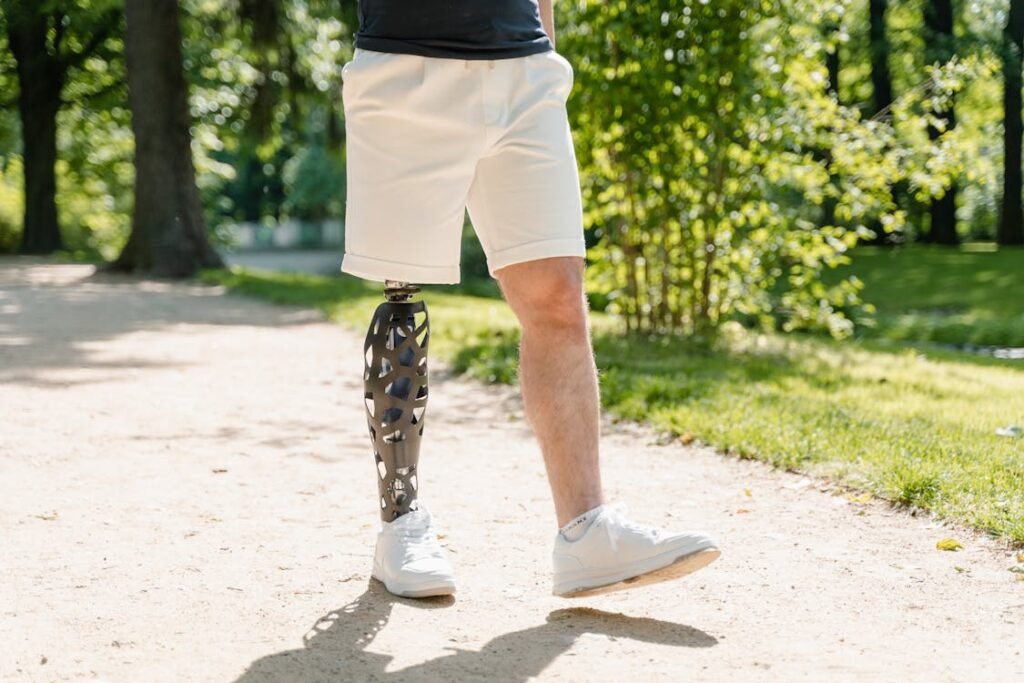
How Gait Training Helps Fine-Tune Prosthetic Alignment to Prevent Pain
When Fit Looks Good on Paper — But Feels Off in Reality
A prosthesis can look perfect in design. The alignment may appear correct on a static test. The socket might feel snug. The limb might check all the boxes during a fitting. But the true test of a prosthesis isn’t how it performs in the clinic — it’s how it performs while walking, again and again, in real life.
This is where gait training does something that no measurement tool or pressure sensor can. It reveals how the prosthetic actually works with the body in motion. A trained eye — like that of a physical therapist or gait specialist — can spot subtle shifts that indicate misalignment: the hips tilting too much with each step, the foot slapping down too hard, the pelvis rotating during push-off, or the spine compensating with a slight lean.
These small signs often point to something deeper: that the alignment of the prosthetic limb, though technically acceptable, is not quite right for that person’s body, walking style, and muscle dynamics. Without gait training, these clues might be missed — and the person ends up adjusting their body around the device, rather than fine-tuning the device to support their natural gait.
Improper Alignment Leads to Compensations — and Compensations Lead to Pain
When alignment is off, even by a few degrees, the body notices. It might start with something as simple as a limp or a slower pace. But the body doesn’t stop there. It finds ways to “fix” the issue — usually by shifting weight, tightening certain muscles, or adjusting posture. These compensations might feel like improvements in the moment, but they come with a price.
One hip might become overused. One shoulder might rise with every step. The back might arch more. These patterns, repeated hundreds or thousands of times a day, create strain. Over time, that strain becomes discomfort — and eventually pain.
Gait training plays a key role in stopping this cascade early. By analyzing walking patterns, therapists can identify signs that the prosthesis needs adjustment — even before the user begins to feel actual pain. They don’t just look at how far the person walks. They look at how each joint responds with every step. That real-time, movement-based insight is often what leads to the most effective prosthetic tweaks.
A Dynamic Partnership: User, Prosthesis, and Practitioner
Successful prosthetic use is not a one-way street. It’s a partnership — between the user’s body, the prosthetic limb, and the team supporting them. Gait training is where this partnership is tested, refined, and strengthened.
During training, users often learn to describe their experience more clearly. They begin to notice when something feels “off,” even if they can’t explain it. They gain the language and awareness to say, “I feel like I’m dropping on one side,” or “I notice my foot turns out when I speed up.” These observations, when shared with a skilled prosthetist, lead to smarter alignment adjustments.
Without gait training, users may not realize their discomfort is coming from alignment. They may think they just need to “get used to it,” when in fact, a small change in foot rotation, socket angle, or heel height could relieve the pressure completely. Training sessions allow for constant feedback between the user and the rehab team, turning vague discomfort into actionable improvements.
Pain Prevention Through Personalized Adjustment
Every body is different. Muscle tone, residual limb length, core stability, spinal flexibility — all of these affect how a prosthesis interacts with the body. That’s why gait training shouldn’t just follow a fixed protocol. It should be personalized and flexible, built around what the user’s body is showing in motion.
This is especially true for users who are active, older, or have unique needs due to multiple surgeries or conditions. What works for one amputee might not work for another. Gait training helps surface these differences early. It transforms alignment from a one-time setup into an ongoing process of refinement.
At Robobionics, we view prosthetic alignment as something that evolves with the user. As they grow stronger, their gait changes. Their stride length might increase. Their posture may improve. These changes shift how the prosthesis works — and periodic training sessions help adjust for this growth, keeping the body pain-free and fully supported.
Conclusion
Pain doesn’t have to be part of life after limb loss. Yet for many amputees, discomfort in the back, hips, or knees slowly becomes a daily companion — not because something is wrong with the prosthesis, but because the body never got the chance to relearn how to move the right way. That’s where gait training becomes not just helpful, but absolutely essential.
Gait training is much more than learning to walk again. It’s a protective tool. It teaches the body how to stand tall, shift weight evenly, and avoid the small compensations that lead to big problems over time. It builds confidence, restores balance, reduces pressure on the sound limb, and helps users move with freedom instead of fear.
At Robobionics, we’ve seen how the right training, at the right time, can change everything. Pain fades. Movement improves. Life opens back up. Whether someone is just beginning their journey or has been using a prosthesis for years, it’s never too late to walk better — and feel better.
Because every step should feel strong, stable, and free from pain. And that begins with gait training done right.



